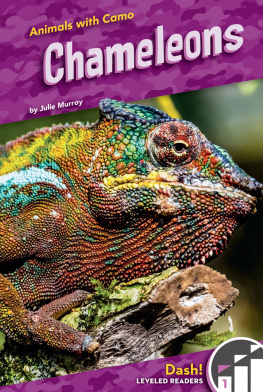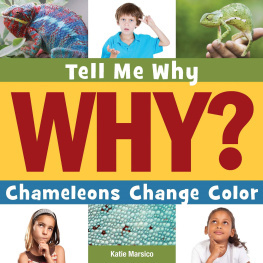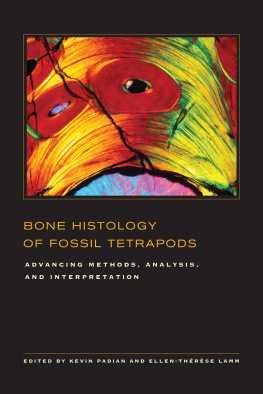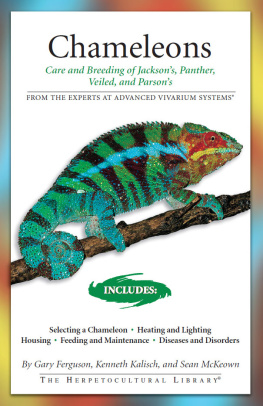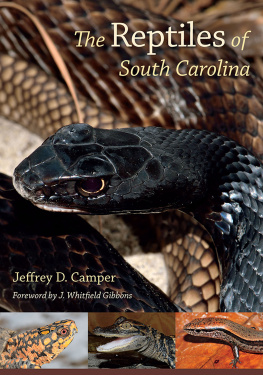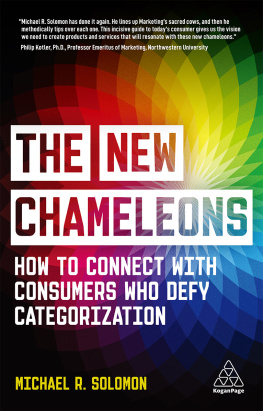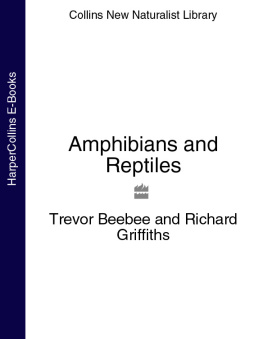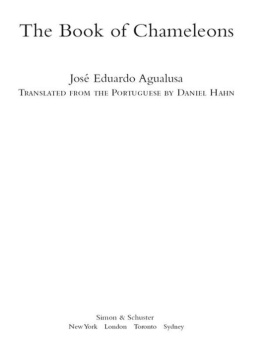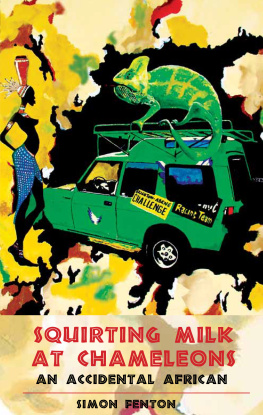
The Biology of Chameleons
The Biology of Chameleons
Edited byKRYSTAL A. TOLLEY and ANTHONY HERREL

UNIVERSITY OF CALIFORNIA PRESS
BerkeleyLos AngelesLondon
University of California Press, one of the most distinguished university presses in the United States, enriches lives around the world by advancing scholarship in the humanities, social sciences, and natural sciences. Its activities are supported by the UC Press Foundation and by philanthropic contributions from individuals and institutions. For more information, visit www.ucpress.edu.
University of California Press
Berkeley and Los Angeles, California
University of California Press, Ltd.
London, England
2014 by The Regents of the University of California
Library of Congress Cataloging-in-Publication Data
The biology of chameleons / edited by Krystal Tolley and Anthony Herrel.
pagescm.
Includes bibliographical references and index.
ISBN 978-0-520-27605-5 (cloth : alk. paper)
eISBN 9780520957381
1. Chameleons.I. Tolley, Krystal.II. Herrel, Anthony.
QL 666. L 23 B 562013
597.956dc232013026609
Manufactured in the United States of America
22 21 20 19 18 17 16 15 14 13
10 9 8 7 6 5 4 3 2 1
The paper used in this publication meets the minimum requirements of ANSI/NISO Z 39.48-1992 ( R 2002) ( Permanence of Paper ). 
Cover illustration: Trioceros johnstoni from the Rwenzori Mountains, Uganda. Photo by Michele Menegon.
CONTENTS
Krystal A. Tolley and Anthony Herrel
Christopher V. Anderson and Timothy E. Higham
Anthony Herrel
Timothy E. Higham and Christopher V. Anderson
G. John Measey, Achille Raselimanana, and Anthony Herrel
Devi Stuart-Fox
Krystal A. Tolley and Michele Menegon
Colin R. Tilbury
Arnau Bolet and Susan E. Evans
Richard Jenkins, G. John Measey, Christopher V. Anderson, and Krystal A. Tolley
CONTRIBUTORS
CHRISTOPHER V. ANDERSON
Department of Integrative Biology
University of South Florida, USA and Department of Ecology and Evolutionary Biology, Brown University, Providence, Rhode Island, USA
ARNAU BOLET
Institut Catal de Paleontologia Miquel Crusafont and Universitat Autnoma de Barcelona
Sabadell, Spain
SUSAN E. EVANS
Research Department of Cell and Developmental Biology
University College London
London, United Kingdom
ANTHONY HERREL
Centre National de la Recherche Scientifique and Musum National dHistoire Naturelle
Paris, France
TIMOTHY E. HIGHAM
Department of Biology
University of California
Riverside, California
RICHARD JENKINS
Durrell Institute of Conservation and Ecology
School of Anthropology and Conservation
The University of Kent and IUCN Global Species Programme
Cambridge, United Kingdom
G. JOHN MEASEY
Department of Zoology
Nelson Mandela Metropolitan University
Port Elizabeth, South Africa
MICHELE MENEGON
Tropical Biodiversity Section
Museo Tridentino di Scienze Naturali
Trento, Italy
ACHILLE RASELIMANANA
Department of Animal Biology
University of Antananarivo and Association Vahatra
Antananarivo, Madagascar
DEVI M. STUART-FOX
Zoology Department
The University of Melbourne
Australia
COLIN R. TILBURY
Evolutionary Genomics Group
University of Stellenbosch
South Africa
KRYSTAL A. TOLLEY
South African National Biodiversity Institute
Cape Town, South Africa
FOREWORD
In putting together this book, we stand on the shoulders of others. The extensive bibliography presented here spans centuries, and the resulting body of literature is based on the work of researchers who dedicated their minds to a deeper understanding of chameleons. We have taken pieces of this great puzzle and have made a start at constructing the whole picture, but there are many glaring gaps. In some respects, it seems there are too many pieces missing and the emerging picture is only a hazy nebula of unclear, scattered, and fragmented bits. But the excitement that comes with the challenge of scientific thought, of asking the questions why and how, is what compels us to keep looking for the missing pieces. For chameleons, the many missing pieces are the why and how of their remarkable evolutionary radiation, and we must keep questioning, even if we never complete the puzzle.
Although this book is built on the works of others, putting together this volume has been a group effort of the authors, all of whom enthusiastically came to the party. Each author brought their own expertise, and together we have made something more than any one of us could have done alone. It has been an extraordinary experience working with this team. As editors, we expected to be herding cats, but on the contrary, the process was surprisingly smooth. Of course, each of the chapters was reviewed by our peers, all of whom invariably provided positive and constructive criticism on the content. It is surprising how many things we missed initially, and we owe much to our colleagues for taking time to review and comment on these chapters: Salvidor Bailon, Bill Branch, Angus Carpenter, Jack Conrad, Frank Glaw, Rob James, Charles Klaver, Lance McBrayer, John Poynton, Phil Stark, Andrew Turner, James Vonesh, Bieke Vanhooydonck, and Martin Whiting. We are grateful to several friends and colleagues who permitted complimentary use of their photos, including Bill Branch, Marius Burger, Tania Fouche, Adnan Moussalli, Devi Stuart-Fox, and Michele Menegon. We also owe much to Chuck Crumly for eagerly taking on the initial responsibility of producing this book, as well as the National Research Foundation of South Africa and Centre National de la Recherche Scientifique and Groupement de Recherche International for providing the funds that allowed the editors of this volume to collaborate and to aspire. The follow-up production team at UC Press (Lynn Meinhardt, Ruth Weinberg, Kate Hoffman, Blake Edgar, and Deepti Agarwal) were excellent in providing advice and assistance throughout the process. In all, this has been a brilliant experience, despite initial reservations in taking on such a big project. Its clear that the ease of putting this together was due to an outstanding team of authors, all of whom are passionate about their subject and have not forgotten how to ask why.
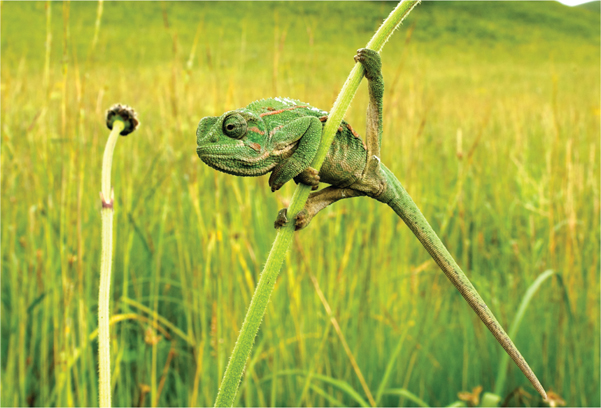
Trioceros goetzei shows the dexterity of the chameleons gripping hands and feet.
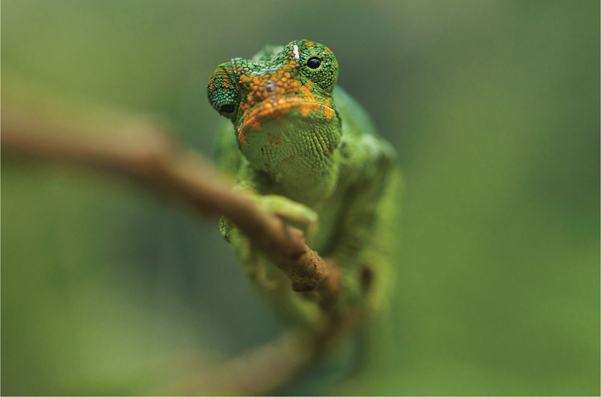
Trioceros johnstoni from Rwanda demonstrates the independently moving eyes typical of all chameleons.
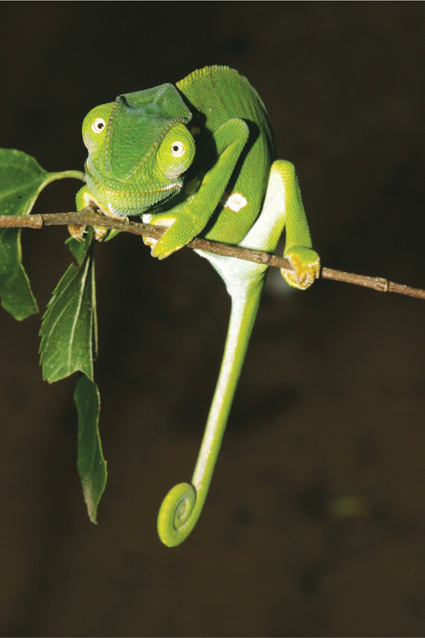
The visual system of chameleons is highly tuned for judging distance and movement, as shown by the focused gaze of Chamaeleo dilepis.
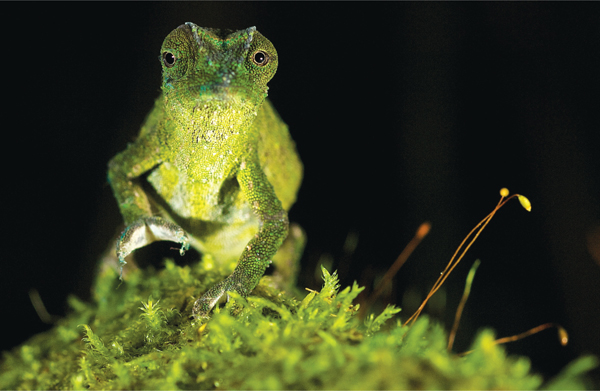
Rhampholeon viridis from Tanzania is typical of chameleons, which are primarily terrestrial.
Next page

